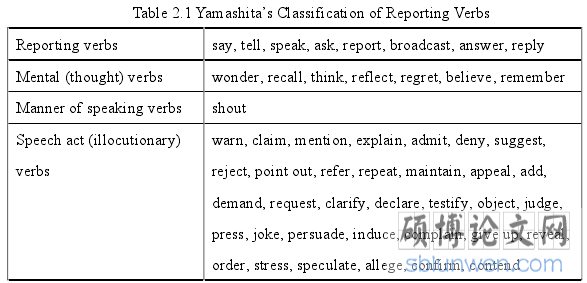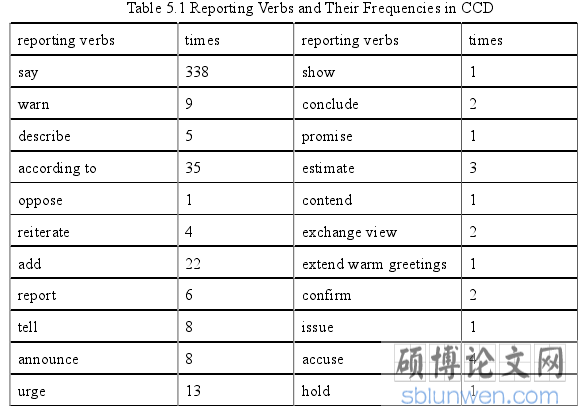Chapter One Introduction
1.1 Background of the Study
For the past few years, the burgeoning development of mass media has enabled people to get access to latest information quickly and conveniently via the Internet. Among all kinds of channels of information, news reports are of great importance in disseminating information due to their characteristics of timeliness, conciseness and authenticity, in which news reporters express subjective opinions in a seemingly “objective” way. Therefore, the main functions of news reports for their audiences are to deliver information, reflect and guide public opinions. Reported speech typically plays a crucial role in this process since it reflects the subjective and objective dynamic. Xin (2007) argues that the main purpose of reported speech in news discourse is to add a sense of authenticity to the report, to show the objectivity of the report, and to convince the readers that the reporter does not mix his or her private opinions (Xin, 2007, p. 103). News reports always express subjective opinion in a seemingly “objective” way, in which reporting verbs play an important role. Reporting verbs constitute the most direct context of quotation, which possess the function of predicting and controlling the understanding of the reported speech (Xin, 2008, p.61). Therefore, the study on reporting verbs deserves attention. However, researches on reporting verbs in news discourses should not be limited to language itself. Tian (2016) defines discourse as the application of language in all kinds of social occasions, thus, discourse contains various factors relating to language usage, such as the social status of the language users or institutional interests (Tian, 2016, p.4). In this sense, studies on reported speech must refer to the interests and value of all parties involved. As a result, combining critical discourse analysis (CDA) with reporting verbs enables people to unveil the covert ideology and power relations of news discourses.
.........................
1.2 Significance and Objectives of the Study
As has been mentioned in the above, reported speech implicates news reporters’ ideology and attitude, or the government and country they serve, and reporting verbs incarnate the attitude of the reporter. Therefore, the present study aims to dig into the ideology hidden in the reporting verbs from China Daily and The Washington Post. Firstly, this thesis attempts to make a theoretical comparison of reporting verbs appearing in the two newspapers by analyzing their distribution and frequency respectively, and the social and political factors that exert implicit impact on the news will be explored. Secondly, through finding the difference of reporting verbs of two countries’ news discourses and their hidden ideology, the study also hopes to help readers distinguish reporters’ stance from facts. In addition, it has certain reference value for the discourse practice of news reporting in China, which helps news reporters improve their reporting quality and safeguard our country’s image.
The comparative study of reporting verbs in hard news discourses about the Sino-US trade war is of significance both theoretically and practically. Theoretically, the present thesis attempts to put forward an improved classification of reporting verbs used in hard news discourses, which enables the present study to further enrich the theory and perspective of news reporting verbs studies. Besides, a refined analytical framework for reporting verbs in hard news is also proposed. In addition, corpus will be adopted as the research tool in this thesis, which can verify the feasibility of the combination of corpus and CDA, and benefits the theoretical construction of CDA.
........................
Chapter Two Literature Review
2.1 Definition of Related Concepts
In order to dig into previous researches on reporting verbs, related concepts must be presented in advance, which shores up the working definition and analytical framework employed in this thesis.
2.1.1 Definition of Hard News Discourse
News report discourse is one of the most commonly used channel for people to get latest information and gain insights into the society we live in. It is a literary form that mass media use to depict and record social realities, and to spread information globally. However, news is not merely the accumulation of information since news reports sometimes contain different voices, such as quotes from others or private opinions given by news reporters.
Bennett (1983, p. 125) defines news as “information that is timely, relevant to the concerns of its audience, and presented in a form that is easy to grasp”. In other words, news can be deemed to be a sort of texts that enables people to gain information timely with easily-understood contents. Geis (1987, p.130) believes that “a news report on some event will normally consist of two things: descriptions of events---what has happened, is happening or may happen---and descriptions of talk---what people have said (or sometimes, what people haven’t said) in connection with what has happened, is happening, or may happen”.
In addition, one can divide news report discourse into several categories. Bell (1991) classifies news report discourses into four categories, which are feature articles, hard news, headlines, special-topic news, subheadings or crossheads, photo captions, bylines. The current study focuses on hard news reports, which emphasize on the timeliness, objectivity and authenticity of information. Zhang (1998, p.62) considers hard news as a kind of dynamic news, which stresses timeliness and significance, and lays emphasis on the rapid delivery of information, and it is basically consistent with the domestic dynamic information in form. Kuai (2018, p.132) regards hard news as a traditional news mode, and it can best reflect and highlight the advantages of news. It focuses on dynamic reporting, and the reporting is simple and clear based on facts. The substance and content of hard news are relatively serious, and it is more ideological, guiding and political.
.................................
2.2 Definition and Classification of Reporting Verbs
Recent years have witnessed a prominent upsurge of interest in reporting verbs in all genres, with a wide array of studies dealing with this object either directly or indirectly. However, there is rarely consensus about the definition or classification of reporting verbs, which varies from one scholar to another because of diverse individual research backgrounds and interest.
2.2.1 Definition of Reporting Verbs
According to Leech and Short (1981), the selections of reporting verbs remain decisive to the impact of news reporting since they express the sentiment of the speaker or the reporter. Therefore, the exploration of reporting verbs can help readers find out reporters’ control on the original utterances.
In a reported sentence, the reporting verb connects the speaker or writer and the quotation, which makes the reporting verb a signal of reporting behavior. A reporting verb is usually the link between the source of reported speech (S), the hear (H) and the reported proposition (P), and the most common syntax structure in English is S – V - (H) -P and S - V - (to H) - P. Here are some examples:
Bell (1991, p.207) argues that “speech verbs can convey the stance of either the speaker or the reporter to the statement that follows. They have the function of predicting and controlling the discursive meaning. The verb can be evaluative, keying the audience in how to interpret the speaker’s statement.” Thus, reporting verbs serve to construct the context of reported speech, and the choice of reporting verbs embodies news reporters’ means of control. In the current study, the author defines reporting verbs as words that construct the context of reported speech, including verbs and gerundial phrases.

............................
Chapter Three Theoretical Framework .................................... 17
3.1 Theoretical Framework Based on Critical Discourse Analysis ......................... 17
3.1.1 A Brief Introduction to Critical Discourse Analysis ............................... 17
3.1.1.1 The Definition and the Objective of CDA ............................ 17
3.1.1.2 Research Methods of CDA ................................ 18
Chapter Four Methodology .................................... 22
4.1 Research Questions ..................................... 22
4.2 Research Method .................................. 22
Chapter Five Contrastive Analysis of the Two Corpora .............................. 26
5.1 Description of Frequency and Distribution of the Collected Data .................... 26
5.2 Interpretation of Similarities and Differences in the Two Corpora .................... 31
Chapter Five Contrastive Analysis of the Two Corpora
5.1 Description of Frequency and Distribution of the Collected Data
As mentioned above, 64 hard news discourses in total are selected from China Daily and The Washington Post, and both of them construct a corpus containing 32 hard news discourses respectively. Hard news discourses consist of plentiful reported speech, where reporting verbs connect the news resources with reported contents. According to Fairclough’s three-dimensional framework (1989), the first stage of critical discourse analysis is the description of the text. Therefore, the frequencies and distribution of reporting verbs in the two corpora must be described. All reporting verbs appear in CCD and CTWP are listed as follows:

.............................
Chapter Six Conclusion
6.1 Major Findings and Implications of this Study
Previous chapters conduct a contrastive analysis of reporting verbs in China Daily and The Washington Post from the perspective of CDA. Through the analysis, one can see that there exist certain similarities as well as variations between the two newspapers in terms of the using of reporting verbs based on the topic of the trade war between China and the United States.
There are some common features of reporting verbs usage in hard news discourses in the two corpora. In the first place, the neutral reporting verbs are used most frequently and take up the largest part of the total reporting verbs, occupying over 65% in both corpora. In this category of reporting verbs, the frequencies of the word “say” are evidently largest. This is due to the genre of hard news discourses, which is featured by being objective and impartial, so these two newspapers employ neutral reporting verbs most. Secondly, the proportion of performative reporting verbs used in the two corpora is similar, taking up 23.35% and 28.51% respectively. Besides, probing into the news sources and the reporting modes of the reported speech helps the research on reporting verbs.
Meanwhile, significant differences also exist in the use of reporting verbs. Firstly, the total frequencies of reporting verbs in CCD are significantly more than that of CTWP, even though the word counts of CCD are fewer than that of CTWP, it still reaches statistical significance. In addition to the report on the news event itself, the report on the comments of others is also an important part. At this point, China Daily is particularly outstanding. Secondly, there are more neutral reporting verbs in CCD than those in CTWP, which also reaches statistical significance. Thirdly, there are seemingly more emotive reporting verbs in CTWP than those in CCD, which reaches statistical significance as well. It should be noted that although this thesis attempts to explore the use of reporting verbs, it doesn’t mean that reporters intend to distort the news event or even cheat their readers. The follow-up analysis digs into the deep-rooted reasons for these variations from economic and political perspectives, which denotes the fact that news is not a value-free reconstruction of events, but rather a reflection of facts through language relating to ideology.
reference(omitted)
